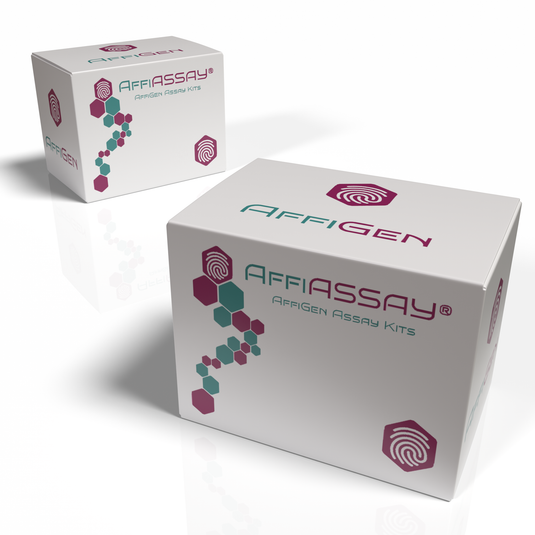AffiASSAY® Cell Counting Kit 8 (WST-8 / CCK-8)
The AffiASSAY® Cell Counting Kit 8 (WST-8 / CCK-8) is a reliable and easy-to-use assay designed for the rapid and accurate quantification of cell viability and proliferation. This kit utilizes a colorimetric method based on the reduction of a water-soluble tetrazolium salt (WST-8) by cellular dehydrogenases in viable cells to produce an orange-colored formazan dye. The intensity of the dye is directly proportional to the number of living cells in the sample, providing a sensitive measure of cell viability and proliferation.
Key Features:
-
Rapid and sensitive: Provides accurate results within a short incubation period.
Wide applicability: Compatible with a variety of cell types, including adherent and suspension cells. - High throughput: Suitable for high-throughput screening applications.
- Versatile: Can be used for cell proliferation assays, cytotoxicity assays, and drug screening assays.
- Stable signal: Offers stable and reproducible results over a wide range of cell densities and experimental conditions.
Assay Principle:
The AffiASSAY® CCK-8 kit utilizes the water-soluble tetrazolium salt WST-8, which is reduced by cellular dehydrogenases in viable cells to form a water-soluble formazan dye. The intensity of the orange-colored formazan dye produced is directly proportional to the number of living cells in the sample. The absorbance of the formazan dye can be measured spectrophotometrically at a wavelength of 450 nm using a microplate reader.
Applications:
-
Cell viability assays: Determine the number of viable cells in culture.
-
Cell proliferation assays: Assess the rate of cell proliferation and growth.
-
Cytotoxicity assays: Evaluate the cytotoxic effects of compounds or treatments on cells.
- Drug screening assays: Screen potential drug candidates for their effects on cell viability and proliferation.
Kit Contents:
- CCK-8 reagent: WST-8 tetrazolium salt solution
- User manual: Detailed instructions for assay setup and data analysis
Storage and Stability:
- The components of the AffiASSAY® CCK-8 kit should be stored at the recommended temperature (-20°C) and protected from light. When stored properly, the kit is stable for up to 24 months from the date of manufacture.
- The kits is stable for 12 months at +4°C.
Precautions:
- For research use only. Not for diagnostic or therapeutic purposes.
- Handle all reagents with care and follow the instructions provided in the user manual.
- Avoid exposure of reagents to light during storage and assay procedures.
- Use appropriate safety precautions when working with cell cultures and laboratory chemicals.
References:
- Doi, K., et al. (1995). A novel water-soluble tetrazolium salt for colorimetric cell viability assay. Analytical Biochemistry, 227(2), 328-335.
- Ohno, R., et al. (1993). A novel water-soluble tetrazolium salt for non-enzymatic cell viability assay. Oncology Reports, 31(5), 2379-2383.
Why Choose AffiASSAY®?
Our commitment to excellence and scientific rigor makes AffiASSAY® the trusted choice of researchers worldwide. We strive to provide you with innovative tools that deliver precise results and accelerate your research efforts.
AffiASSAY® Cell Counting Kit 8 (WST-8 / CCK-8) Protocol:
[Please note that this protocol is a general guideline, and you should always refer to the specific instructions provided in the kit manual for accurate and detailed information.]
Materials Needed:
- AffiASSAY® Cell Counting Kit (CCK-8)
- Cell culture medium
- Cells of interest
- 96-well microplate
- Pipettes and tips
- Microplate reader capable of measuring absorbance at 450 nm
Protocol:
Prepare Cell Culture:
-
Culture cells of interest according to standard protocols in appropriate culture vessels until they reach the desired confluence or growth phase.
Prepare Working Solution:
- Thaw the CCK-8 reagent and allow it to equilibrate to room temperature.
-
Prepare the CCK-8 working solution by diluting the CCK-8 reagent with fresh cell culture medium at a ratio of 1:10 (e.g., 10 μL of CCK-8 reagent + 90 μL of medium per well). Prepare enough working solution for all wells to be assayed.
Seed Cells in Microplate:
- Aspirate the culture medium from the cells and wash once with phosphate-buffered saline (PBS) if necessary.
-
Add the appropriate volume of fresh cell culture medium containing cells to each well of a 96-well microplate. Adjust the cell density according to the experimental requirements.
Incubate Cells with CCK-8 Reagent:
- Incubate the microplate containing cells with the prepared CCK-8 working solution. Ensure each well is evenly covered with the solution.
- Incubate the microplate at standard cell culture conditions (e.g., 37°C, 5% CO2) for a specified period of time (typically 1-4 hours). The optimal incubation time may vary depending on the cell type and experimental conditions.
Measure Absorbance:
- After the incubation period, gently mix the contents of each well by pipetting up and down or using a plate shaker.
- Measure the absorbance of each well at 450 nm using a microplate reader. Ensure to use a reference wavelength if necessary according to the manufacturer's instructions.
Data Analysis:
- Record the absorbance values for each well.
- Calculate the cell viability or proliferation using the formula provided by the manufacturer or based on the specific experimental design.
-
Analyze the data and interpret the results accordingly.
Quality Control:
- Perform appropriate controls, including background controls (no cells) and positive controls (e.g., untreated cells or cells treated with known compounds).
- Ensure all reagents are handled and stored properly according to the manufacturer's instructions to maintain assay reliability.
Troubleshooting:
- If unexpected results are obtained, troubleshoot the assay by checking experimental conditions, reagent handling, and protocol adherence.
- Consult the user manual or contact technical support for further assistance if needed..
Dispose of Reagents:
- Dispose of all reagents and materials according to local regulations for biohazardous waste or chemical waste disposal.

